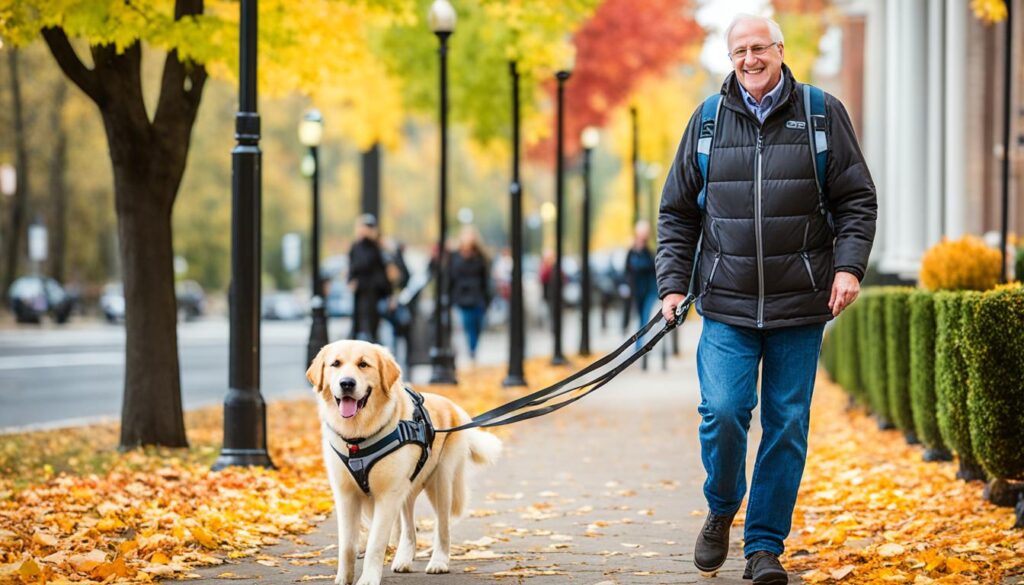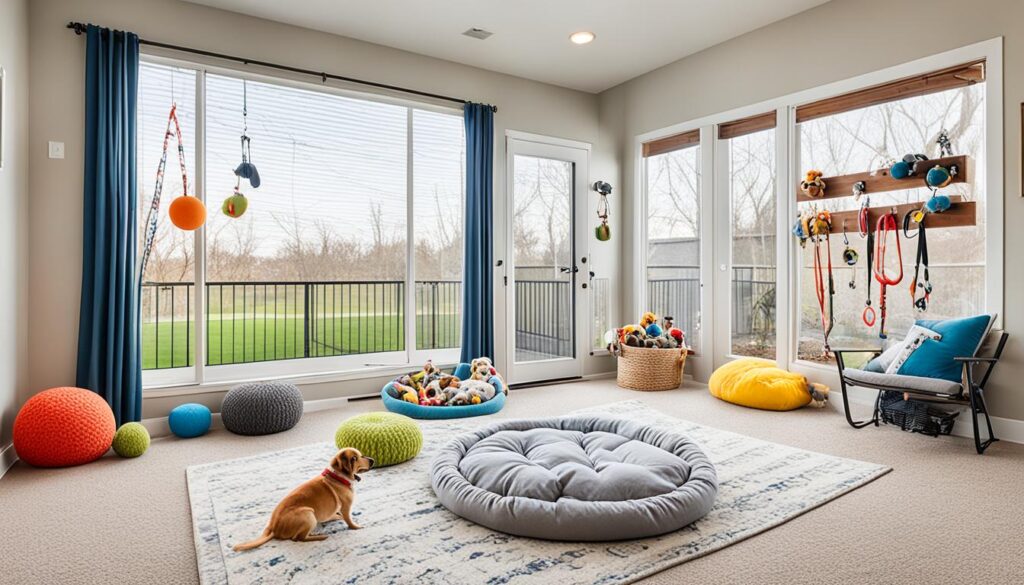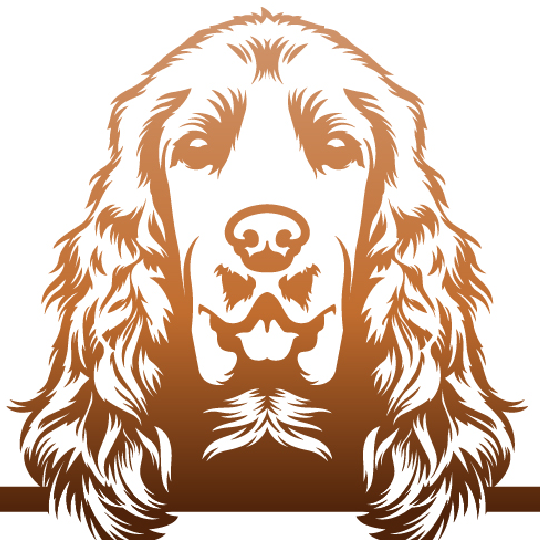Embarking on a promenade with your visually impaired pooch doesn’t have to be a challenge if you’ve got the right touch—and talking about the “right touch,” we mean both figuratively and literally. On Australia’s resplendent Gold Coast, the pros at “All For Furry Friends” have mastered the art of the safe dog walk, ensuring that every step taken is a symphony of synchronized movements that echo comfort and security. It’s about turning a necessity into an enjoyable dog walk, full of sniffs, wags, and cherished companionship.
So, how do you walk a blind dog with the finesse of a maestro? It isn’t merely about clipping on the leash and stepping out the door; it’s a subtle craft of guiding blind dogs, a dance of trust and intuition on the sun-drenched sidewalks where every aroma tells a story and every texture sings a sonnet. Transforming the mundane into the extraordinary, each outing becomes less about the navigating walkways, and more about the journey shared, paw in hand, with your beloved four-legged confidante.
Key Takeaways
- Understanding your guide-role can turn a simple outing into an adventure for your visually impaired pooch.
- Patience and empathy are key when learning how to navigate the world anew together.
- Ensuring walks are safe is paramount; be the eyes they trust and the guide they rely on.
- Consistency in your walking routine provides comfort in a world that’s altered for your furry friend.
- Discover joy in the little victories, like breezing through a previously tricky turn.
- A well-worn path can hold as many wonders for a blind dog as a bouquet does for us.
Understanding Your Blind Dog’s World
While their world may change, their zest for life remains unswayed. Dogs may be more robust than you think, with many showing incredible blind dog resilience when confronted with vision loss. Of course, this doesn’t mean they can navigate this transition alone—they need a helping paw to find their way. Knowing the symptoms of dog vision loss is crucial for providing the support your tail-wagging pal needs.
The Resilience of Dogs to Vision Loss
In the canine world, where the wag of a tail speaks volumes, losing sight might not spell disaster. Our furry friends may not rely on vision to the same extent we do, quickly adapting by tuning in their other senses to the world around them. From the ultrasonic whistle of a bat to the comforting scent of their owner’s slipper, their capacity for sensing the environment barely skips a beat.
Recognizing Signs of Vision Impairment in Dogs
Though dogs may not pen sad tales of their vision loss, as stewards of our canine compatriots, it’s our duty to acknowledge the signs. Mel from the sunlit paths of Gold Coast, an expert in walking blind dogs, observes several indicators that your mutt might be missing more than just that last catch.
From the subtle stumble over favorite toys to a reluctant tail on what used to be thrill-filled walkies, recognizing dog blindness early makes for smoother sailing down blind dog lane.
Recognizing dog blindness is part crystalline observation, part perceptive intuition. Keep your eyes peeled for these telltale symptoms of dog vision loss:
- Is Rover now clumsier than a pup on its first outing?
- Do toys seem to have mastered the art of hide and seek?
- Are once fearless fidos now startled by the stealthy approach of their food bowl?
- Could those peepers be cloudier than a foggy morning’s stroll on the shore?
- Are they blinking back eye pain like a champ?
- Has the usual pooch pep turned into a slow-motion saunter?
When signs such as these emerge, tarry not in seeking the wisdom of your vet or an eye specialist—stat!
| Symptom | Details | Action |
|---|---|---|
| Clumsiness | Bumping into objects | Consult a vet |
| Toy Troubles | Trouble locating playful paraphernalia | Check for vision clarity |
| Startle Reflex | Easily spooked by sudden movement | Soft approach & voice cues |
| Cloudy Eyes | Misty, opaque appearance | Vet check for cataracts |
| Eye Pain | Squinting, watery eyes | Immediate vet attention |
| Low Energy | Less enthusiasm for walks | Assess for other symptoms |
Conditions like cataracts or glaucoma may play the marauding bandits stealing your pup’s eyesight, but fret not! With a vet’s guidance, you can sometimes give the thief the slip, restoring some of what was pilfered. Should the vet’s proclamation be “irreversible,” remember, this is not the end of your dog’s joyous jaunts—merely a new chapter in how you both will experience them.
In a twist of irony, while navigating the trajectory of your blind dog’s life, it might just be their unseeing eyes that lead you to newfound appreciation for your unparalleled bond. With patience, consistency, and above all, love, you and your canine confidante will walk through this world, blind dog resilience on full display.
How to Walk a Blind Dog
Walking a blind dog may seem like a daunting task, but it’s an opportunity to strengthen your bond and enhance your dog’s life immensely. Whether you’re just starting out or refining your technique, a key element in your walking guide for blind dogs is patience harmonized with an understanding of your dog’s perception of the world. Here are a few canny tips for walking blind dogs that can make every outing an escapade of discovery and joy for your sightless sidekick.
Guiding a furry friend without sight is less about the destination and more about the journey. It’s a lesson in trust, and every successful walk reinforces this bond.
When assisting blind dogs on walks, communication is your golden ticket. Chat with your pup continuously; it’s not only comforting but also provides auditory cues about your location and intentions. Aim to build a consistent walking routine—akin to a familiar symphony—so that your dog can waltz confidently through familiar movements, even without sight.
Equally vital is establishing that your dog is visually impaired to passersby. Blind dog walking techniques include decking out your dog with a vest or collar tag for the world to see. This simple gesture is like flashing a little neon sign that says “Careful, I’m blind,” preventing any potential canine collisions or unwarranted pats that could unsettle or alarm.
- It’s a tease of a breeze when your dog can feel which way the wind (and their human) is blowing.
- A rustling leaf or a gentle jingle can be as alluring as a siren’s song, making sound cues imperative for navigation.
- Ensuring that the horizon line of your home is clear from clutter helps to prevent any unscheduled pit stops or fido faux pas.
These small steps in your routine can make significant strides in building your dog’s confidence and creating a secure, happy environment for your sightless explorer. Remember, while your dog’s vision may be impaired, the zest for zigzagging throughout the neighborhood doesn’t have to be!
With the right tips for walking blind dogs, each saunter can become a sensational experience for both of you, filled with familiar tunes, reassurance, and an occasional sniff symphony. Strap on that vest, and let’s go see the world… or rather, be the world your blind dog gets to explore.
Establishing a Consistent Walking Routine
Navigating the world without sight can seem daunting for many, but not so much for our furry friends blessed with a mélange of keen senses. These whip-smart pooches can whisk through their walks with elegance, so long as there’s a melody of consistency they can tap their paws to. Indeed, a consistent walking routine stands as the unspoken poetry between a blind dog and its human, penned with every familiar crunch of the gravel underfoot.
It’s the subtle spice of the familiar which conjures security in their stride—a knowing wiggle in the walk that, “Ah, yes, this is the path that smells of jasmine and sounds like the chorus of morning birds.” You see, the power of repetition in your walking schedule for blind dogs is much like the comfort of a goodnight lullaby—assuring, engaging, and so warmly predictable. When it comes to walking safely with a blind dog, Mel from “All For Furry Friends” can attest that the rhythm of routine is indeed, the heart of blissful strides.

Benefits of Familiar Routes for Visually Impaired Dogs
When the olfactory smorgasbord and symphonies of sound steering our sight-impaired sidekicks outshine the sun itself, you know you’ve hit the familiar route jackpot. The sniffs, the breezes, every grain of sand on the familiar walking routes become the markers of trust, guiding your canine companion home—each time, every time.
Indeed, brisk trots down the known lane morph into a dance with confidence itself, where blind dog resilience twirls around every corner. The conclusive wag of approval? A tail spinning with joy at the realization, “This is my path, and I walk it with my best friend.”
Importance of Consistency in Walking Schedules
Consistency, dear walker—the metronome to your blind dog’s heart, the steady drumbeat to their paws. A walking schedule for blind dogs, marked not by the sunrise nor moon’s crest, but by the unwavering certainty that “Now, it’s time to walk.” It is here, in the cadence of the consistent, that we find the unshakable trust—the untold pact between a guide and a blind adventurer. The happy yips echoing through the hall when the harness jingles? Oh, they spell but one thing: adventure calls and consistency leads.
The ballad of the walk isn’t just paced by the steady clink of the leash—it’s sung by you, the guide, the unwavering north star in your blind dog’s twilight sky. So, button up that waistcoat of patience and step out into the grand waltz of walks, where every sniff and wag tells the tale of a journey perfectly paced by the love of consistency.
Equipping Your Blind Dog for Safety
When it’s a walk in the park, or rather, a park in the walk, your blind dog’s gear should spearhead a safe and enriching escapade. Above all, flaunting the correct blind dog safety gear is akin to donning a superhero’s cape—indispensable. Mel from “All For Furry Friends” wouldn’t dare let their charges trot out unadorned—a philosophy we’re keen to unpack.

Now, let’s dive nose-first into the whiff-worthy world of visually impaired dog equipment that makes tails wag with security. Blind dog safety is not just about the bells and whistles; it’s about crafting a sensory symphony of cues, aids, and unmistakable “I’m here” labels.
Identifying Gear for Visually Impaired Dogs
Like a badge of honor, the right equipment shines a spotlight on your dog’s courage. It can be as simple as a distinctive blind dog collar tag jingling a gentle reminder to all nearby to tread with care. But why stop there when you can envelop your furry confidante in a snug blind dog vest, effectively penning a love letter to their resilience for the whole world to feel?
The Role of Collar Tags and Vests
Collar tags and vests aren’t just fashion statements; they’re a semaphore for compassion in a busy world. The tags sing a gentle jingle of presence, while the vests swath your buddy in a tapestry of tactile tales, telling hands where to pause and admire from afar.
| Gear Type | Purpose | Benefits |
|---|---|---|
| Vests | To identify the dog as blind and protect their body | Visibility, Protection, Instant Recognition |
| Collar Tags | To alert others to the dog’s vision impairment | Easy Identification, Sound Cues, Safety Net |
| Blind Dog Halo | To provide a buffer between the dog and potential obstacles | Spatial Awareness, Prevention of Injuries, Confidence Boosting |
Indeed, a stroll with a visually challenged companion should be less about worry and more about the wonderful ways we can say, “Watch out, world, blind dog bouncing through, living their best life!” Take it from those in the know, like our pal Mel—pairing your dog with the right gear is the first paw-step toward unstoppable adventures. Trust us, your intrepid companion will thank you—with every daring dash and sniff-happy saunter.
Navigating Walks with Sensory Cues
For the seeing-eye human paired with a vision-impaired pooch, a cornucopia of sensory cues for blind dogs awaits, ripe for the picking. We’re not simply escorting our furry friends around the block; we’re conducting an orchestra of smells, sounds, and touch, masterfully guiding them through a world unseen but richly lived. These measures ensure every sniff-and-step adventure is safely choreographed, fusing navigating walks with a blind dog into an art form.

Those well-versed in blind dog walking techniques find that sensory enhancements not only compensate for a lack of sight but also tap into the canine’s extraordinary other senses with a finesse that would make a maestro proud. Let’s unfold the sensory map that every blind dog wishes you knew—bringing clarity to their world, one cue at a time.
- Soundscapes: Imagine directing an orchestra with the tinkling of collar bells and the rhythm of a squeaky toy—the joy it brings to your pal.
- Scents on the Breeze: A whiff of lavender by the gate or a dash of peppermint on the corner; scent-marking turns the neighborhood into an olfactory GPS.
- Textured Touchpoints: The tickle of grass, the cool of tile—a range of textures underpaw sends signals to the canine compass that it’s safe to tread forward.
As our four-legged comrades learn to trust this tapestry of tactile and auditory hints, their steps become sprightly, their snouts confident in the guided gavotte on familiar territory. Here’s a sensory toolkit for those ready to paint the town with cues:
| Cue Type | Description | Advantages |
|---|---|---|
| Auditory Aids | Bells and toys that make distinctive sounds | Create a soundscape that guides and reassures during walks |
| Odor Markers | Specific scents located at strategic points | Enables dogs to map their environment using their stellar sense of smell |
| Texture Triggers | Diverse materials laid out to indicate different areas | Provides tactile feedback for navigation within the home and outdoors |
In the home realm, a runner rug stretches out like a runway, guiding our blind companions from room to room. Outdoors, a choir of sensory cues guides them along navigating walks with a blind dog, creating a world where sight is out of sight but never out of mind. With these techniques in your walk coffer, you affirm—there’s nothing “less” about a leash-led escapade with a blind dog, only more.
Creating a Blind Dog-Friendly Home
Transforming your living space into a blind dog-friendly home goes beyond love; it’s an embrace of awareness and adaption. As our sight-impaired friends unravel the skeins of their environment, a safe haven tailored to their needs fosters independence and tail wags aplenty.

Let’s delve into crafting a sanctuary that respects the nuances of non-visual exploration and embodies a sanctuary of sniff-friendly corners and hazard-free passageways.
Minimizing Home Hazards for Blind Dogs
Imagine the world through the lens of heightened senses other than sight. Our beloved woofers with visual limitations rely on us to minimize home hazards with a thoughtful touch, giving them the playbook to strut around with confidence.
- Walking on four furry legs shouldn’t feel like braving a minefield. Navigate through the lens at doggy’s eye level to spot any sneaky, sharp corners or furniture lying in ambush.
- Consider softening the edges by dressing them up with cushioned corner guards—a stylish safety tip applauded by tail-thumpers and shin-owners alike.
- Staircases may appear as towering mountains to a sightless scout. Erecting baby gates plays defense, ensuring descents are made deliberately rather than by surprise.
- It’s a game of spot the difference, where removing a rug or a chair can disorient even the most scent-savvy dog. Keep your layout static to avoid turning their tactile map upside down.
Consistency with Food and Water Placement
When eyes can’t lead, habits tether. Establish a consistent food placement for blind dogs and they’ll beeline to their bowls with the precision of a homing pigeon. Secure food and water stations are like an unwavering north star to a seafarer—essential.
- Anchor the bowls in the same spot and witness a masterclass in memorization; feel the rumbling purr of approval from the whiskered wanderer finding their refill.
- In this dance of constancy, textures underfoot near their dining area signal a feast’s locale, bordering on a Michelin star experience for the nose-inclined connoisseur.
- Find solace in the steadfastness; as your canine companion learns the unwavering latitude and longitude of their munchies, peace of mind takes residence.
- Unwavering placement isn’t just about convenience—it’s a melodious overture that sings, “You’re home, it’s here, and it’s brimming with delicious certainty.”
And there you have it, a snippet of an epicurean sonnet sung in a world beyond vision—our blind dog-friendly home, a symphony composed of love, safety, and oh, the sweetest spot of predictability.
Accessorizing for Confidence: The Blind Dog Halo
When the world becomes a blur, and darkness cloaks the familiar, our canine companions don’t despair; they persevere. But even the bravest tail-wagger could use a knight’s armor in their unseen battles. This is where a brilliant invention—the blind dog halo—comes to light. It’s not only a nifty accessory; it’s a beacon of protection paving the way for fearless explorations. Let’s delve into how this halo device for blind dogs transforms trepidation into triumph.

How Halos Protect Your Blind Dog
Imagine a guardian bubble, an unseen shield that whispers caution to your sightless pal before they tumble into trouble. The blind dog halo is that guardian—encircling your furry friend’s head, it acts as a bumper against the jarring jabs of life. Couch corners? Not a worry. Coffee tables? Simply an enigma of the past. This halo device for blind dogs serves as their personal navigator, conferring a sense of space and safety to every paw-step they venture.
Introducing Your Dog to a Halo Device
Accessorizing blind dogs can be an exercise in patience, for there’s no haste in true craftsmanship. Introducing your dog to a halo device is a gradual dance of trust and treat. Begin by letting them sniff the halo, whispering affirmations of good boy and girl as you gently acquaint them with their new gadget. Then, with the deftness of a seasoned dog whisperer, fit the halo, ensuring it’s snug yet comfortable—a crown befitting canine royalty on their daily strolls through their kingdom.
| Step | Description | Tips |
|---|---|---|
| 1. Familiarization | Introduce the halo to your dog in a quiet, comfortable setting. | Use positive reinforcement with treats and gentle praise. |
| 2. Fitting | Adjust the halo to comfortably fit your dog’s head. | Ensure it’s secure without causing any strain or discomfort. |
| 3. Short Sessions | Start with brief periods of wear around the home. | Gradually increase the duration as your dog grows accustomed. |
| 4. Supervised Exploration | Supervise your dog’s initial explorations wearing the halo. | Stay close to provide comfort and intervene if necessary. |
As your furry knight dons their halo, emboldened by its embrace, they’ll navigate their realm with newfound vim. No longer will the specter of the unseen loom large, for their halo hums a hymn of protection, a sacred chant of “Here lies adventure, tread without fear.” Accessorizing your blind dog with a halo is not only a compassionate choice; it’s a salute to their indomitable spirit—a spirit that sees no darkness, only boundless possibilities to explore and conquer.
Enhancing Communication on Walks
Mastering the stroll with your sightless sidekick means sharpening your communicative repertoire to a fine point. Indeed, when it comes to communicating with a blind dog, clarity is queen and consistency is king. By peppering your promenades with specific guiding commands for blind dogs and enhancing the ambiance with sound signals, you’re scripting a path of paved assurance for your furry pal.
New Commands for Guiding on Walks
Let’s turn the spotlight to guiding commands for blind dogs. These aren’t just words; they’re audible breadcrumbs on the trail of mutual understanding. Edifying your dog with commands such as “step up,” “left,” and “right” dispels the fog of uncertainty that can cloud their unseeing world. Such directives serve as a GPS for your pooch, ensuring that each forward step is made with confidence rather than caution.
Verbal Cues and Sound Signals for Safety
Rounding out your verbal toolkit are the verbal cues for blind dogs—the soft-spoken words of encouragement that guide as much as they comfort. Accompany these with savvy sound signals that slice through the silence like a lighthouse beam, delivering the message of safety with pinpoint precision. The click of a tongue, the snap of fingers or a unique whistle—they all weave a soundscape of security, helping your sight-challenged companion map their unseen surroundings with their formidable sense of hearing. In essence, we’re not just walking our blind dogs; we’re harmonizing with them in a concert of cues, commands, and signals where every step is a note played in the key of safety.
FAQ
What are the best techniques for guiding blind dogs on walks?
When guiding blind dogs, be sure to maintain consistent verbal communication, establish a routine walking path, and use sensory cues and specialized gear such as a blind dog halo to help them safely navigate their way.
How can I help my visually impaired pooch adapt to vision loss?
Dogs are quite resilient to vision loss and can adapt by relying on their other senses. Facilitate this adaptation by removing hazards, keeping their environment consistent, and using scent and sound cues to help guide them.
What are the signs that my dog might be losing its vision?
Look out for signs such as clumsiness, difficulty locating toys, being easily startled, eye cloudiness, visible redness or discomfort in the eyes, and a decline in energy levels. Consult a vet if you notice any of these symptoms.
Why is establishing a consistent walking routine important for blind dogs?
A consistent walking routine provides blind dogs with a sense of security and helps them memorize and safely navigate familiar routes, which is crucial for their orientation and comfort.
What kind of gear should I use to ensure the safety of my blind dog during walks?
Equip your blind dog with “I’m blind” vests or collar tags to alert others to their condition. Consider a blind dog halo to protect them from bumping into things and enhance their ability to navigate their surroundings independently.
How do sensory cues assist blind dogs during walks?
Sensory cues such as the use of scents, tactile pathways like textured rugs, and auditory signals like bells attached to your body allow your blind dog to follow you confidently and stay oriented on walks.
What modifications should I make to create a blind dog-friendly home?
To create a safe environment, cover sharp corners, remove hazards, ensure consistent placement of food and water bowls, and provide a comfortable resting area without altering its location.
What is a blind dog halo and how does it work?
A blind dog halo is a protective device that fits around your dog’s head and acts as a buffer between them and potential obstacles. It helps them navigate their surroundings without injury.
How can I enhance communication with my visually impaired dog on walks?
Introduce new commands specific to navigating walks, such as “step up,” “stop,” “left,” or “right.” Use consistent verbal cues and sound signals to guide them and ensure their safety.




